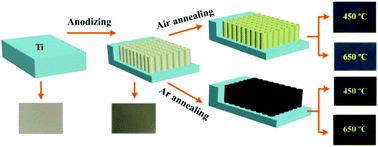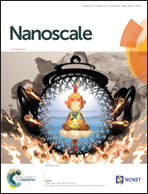Defect-induced betavoltaic enhancement in black titania nanotube arrays†
Abstract
Utilizing high-energy beta particles emitted from radioisotopes for long-lifetime betavoltaic cells is a great challenge due to their low energy conversion efficiency (ECE). Here we report a betavoltaic cell fabricated using black titania nanotube arrays (TiO2 NTAs) by electrochemical anodization and Ar-annealing techniques. The obtained samples show enhanced electrical conductivity as well as Vis-NIR light absorption by the introduction of oxygen vacancy (OV) and Ti3+ defects in reduced TiO2−x NTAs. A 20 mCi63 Ni source was assembled into TiO2 NTAs to form a sandwich-type betavoltaic cell. By I–V measurements, the Ar-annealed TiO2 NTAs at 650 °C exhibited a maximum ECE of 3.65% with Voc = 1.13 V, Jsc = 103.3 nA cm−2, and Pmax = 37 nW cm−2. In comparison with air-annealed TiO2 NTAs, the enhancement of the betavoltaic effect in reduced TiO2−x NTAs can be attributed to the suppression of e–h recombination induced by the generation of OV and Ti3+ defects, serving as electron donors as well as electron traps that not only contribute to the increase of electrical conductance, but also facilitate the charge carrier separation.



 Please wait while we load your content...
Please wait while we load your content...